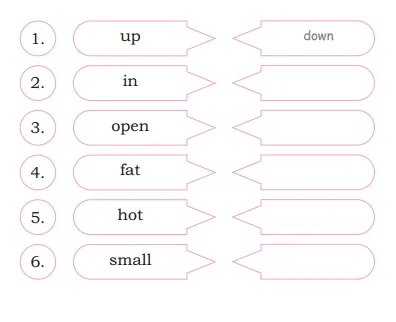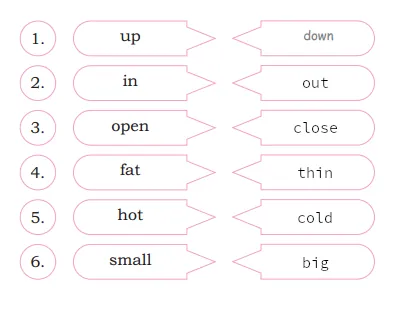This page provides solutions for the exercises in the NCERT Class 2 textbook, Unit 1: Fun with Friends, specifically for the chapters “My Bicycle” and “Picture Reading” from the Mridang series.
Mridang Chapter 1: My Bicycle Solutions
Chapter Summary: The poem “My Bicycle”, tells the cheerful story of a child and their beloved bicycle. It captures the joy of riding, the bicycle’s special features, and the fun experiences they have together. The poem reminds us how bicycles can bring happiness and help us stay healthy.
1. Let us speak – Share with the class
- Have you seen a bicycle?
Answer: Yes, I have seen a bicycle. - Where have you seen it?
Answer: I have seen a bicycle on the road and in my neighborhood. - What colour is it?
Answer: It is green in colour. - Who generally rides it?
Answer: My friend rides it. - Have you seen a tricycle?
Answer: No, I have not seen a tricycle. - Have you seen a wheelchair?
Answer: Yes, I have seen a wheelchair.
2. Let us write – Write the names of the parts of the bicycle in the given boxes.
Refer to the diagram on page 5 of your textbook. Here’s how you can label the parts:
- Top Left: Handle
- Top Middle: Bell
- Top Right: Seat
- Bottom Left: Pedal
- Bottom Middle: Wheel
- Bottom Right: Carrier
3. Let us think
A. Imagine that you have a magic bicycle. Draw it in the box. – This is a creative activity! Draw your magical bicycle and add any features you can imagine.
B. What would you do with your magic bicycle? – If I had a magic bicycle, I would fly to the moon, explore the clouds, and visit all my friends around the world in an instant.
4. Let us write
A. Complete the following sentences.
- The child in the poem has a red bicycle.
- The sound of the bell makes people move aside.
- The tyre and pedals are black.
B. Put a ✓ for the correct sentences and a ✘ for the incorrect sentences.
- The child has a blue bicycle. ✘
- The bell goes trin… trin… trin. ✓
- The child’s bicycle is always fast. ✘
- The child needs some water to keep the bicycle moving. ✘
- The child puts on a little helmet while riding the bicycle. ✓
Vocabulary Words:
- Pedal: The part of a bicycle you push with your feet to make it move
- Aside: To one side.
- Sometimes: Occasionally; on some occasions but not always.
- Track: A rough path or minor road.
- Helmet: A hard or padded protective hat.
- Everywhere: In or to all places.
class 2 – My Bicycle Poem
Mridang Chapter 2: Picture Reading
Chapter summary: Picture Reading in Chapter 2 encourages observation and descriptive skills by exploring a lively playground scene. Children are asked questions to stimulate their imagination and understanding of social settings.
Picture Reading Exercise Solutions
In Mridang Class 2 English Chapter 2, there is a beautiful picture that depicts a lively playground scene. This picture is a great tool for developing observation skills and understanding simple narratives.
Observation Questions and Answers
- What do you see?
Answer: I see children playing in the school playground. - How many children are there in the picture?
Answer: There are 17 children in the picture. - What are the children doing?
Answer: Some children are playing hide and seek, some are talking, and some are playing with marbles. - How are children having fun?
Answer: They are having fun by playing different games. - What games do you play?
Answer: I play hide and seek, cricket, football, etc.
Let us speak – Answer the following questions.
- What games do you like to play with your friends?
Example answer: I like to play badminton, cricket, and hide and seek with my friends. - Have you played bat and ball’?
Example answer: Yes, I have played bat and ball. - Babli made a ball using a few rags, paper, wool and string. Have you tried to play a game using the things around you? What did you play? Name the things that you use to play. Talk about it in the class.
Example answer: I have tried to play a game using things around me. I made a paper airplane and flew it around the room. I used paper to make it. - Read pages 10 – 11 of the story again and number the following sentences in their correct order.
Answer:- Babli hit the ball. – 3
- Jeet threw the ball. – 2
- The ball went into Mohit’s garden. – 4
- Jeet got ready to throw the ball. – 1
- They lost the ball. – 5
Let us write
A. Read the story ‘OUT! OUT!’ again and fill in the blanks.
- Write the names of the children in the story. ___________
Answer: Jeet, Babli and Mohit - Write the items that the children used to make a ball. ___________
Rags, Paper and Wool
B. Write the opposites of the following words. One has been done for you.

Answer:

C. Join the sentences using ‘and’. Write it in the given space. One has been done for you.
- Suresh went to school.
Gopal went to school.
Answer: Suresh and Gopal went to school. - I like to eat mangoes.
I like to eat grapes.
Answer: I like to eat mangoes and grapes. - The cat sat on the mat.
The dog sat on the mat.
Answer: The cat and the dog sat on the mat. - This ball has yellow dots on it.
This ball also has green dots on it.
Answer: This ball has yellow and green dots on it. - There are tables in my classroom.
There are chairs in my classroom.
Answer: There are tables and chairs in my classroom.
Let us do – Activities
A. Choose a partner. Imagine you both are Babli and Jeet. Enact the story. You may use some words from the story for dialogues.
Example story:
B. Ask your grandparents or parents to tell you about a game that they had played in their childhood. Find out about it in detail. The next day speak about it in the class.
DIY
Summary on “Mridang” – Chapter 2: Picture Reading
The chapter from “Mridang” serves as a tool for young learners, especially in their early schooling stages, to engage actively in learning through observation, storytelling, and interactive activities. It focuses on using simple stories and exercises to strengthen children’s reading, writing, and social skills. This structured approach ensures that children connect with the material, feel motivated to learn, and interact with each other in a constructive environment.
Story Synopsis: “OUT! OUT!”
The story “OUT! OUT!” centers on two characters, Jeet and Babli, who enjoy a playful day involving multiple games, including rope skipping, hide-and-seek, and their favorite-bat and ball. While playing, a simple mishap of losing their ball prompts Babli’s creativity as she crafts a new ball from scraps, showing children how to use readily available materials for enjoyment. This story teaches problem-solving and resilience, encouraging children to think creatively.
Interactive Activities and Questions
- Picture Reading and Discussion: Children are encouraged to observe and describe scenes, promoting vocabulary development and the ability to articulate ideas. Teachers can support this by allowing the children to use their mother tongue, facilitating a smoother transition to English vocabulary.
- Role Play and Story Enactment: Children pair up as Babli and Jeet to reenact the story. This interactive exercise not only makes learning fun but also enhances confidence in speaking and listening skills.
- Reflective Questions:
- What games do you enjoy playing with friends?
- Have you created anything to play with from materials around you?
- Discuss an old game your grandparents played.
These activities encourage children to connect with their surroundings, appreciate simpler joys, and understand cultural heritage through games.
Complete NCERT Class 2 English Solutions
| NCERT Solutions | Unit-wise List | Chapter-wise Solutions |
|---|---|
| Unit 1: Fun with Friends | 1. My Bicycle Solutions 2. Picture Reading Solutions |
| Unit 2: Welcome to My World | 3. It Is Fun Solutions 4. Seeing without Seeing Solutions |
| Unit 3: Going Places | 5. Come Back Soon Solutions 6. Between Home and School Solutions 7. This is My Town Solutions |
| Unit 4: Life Around Us | 8. A Show of Clouds Solutions 9. My Name Solutions 10. The Crow Solutions 11. The Smart Monkey Solutions |
| Unit 5: Harmony | 12. Little Drops of Water Solutions 13. We Are All Indians Solutions |
Conclusion
NCERT Class 2 Unit 1 Fun with Friends (My Bicycle and Picture reading) of “Mridang” textbook – engages children with relatable themes, like riding a bicycle and creating new games, to develop both language skills and personal growth. Through poems, stories, and hands-on activities, solutions, children learn valuable life skills, such as creative thinking, teamwork, and responsibility. The exercises promote collaboration, language development, and love for learning.
